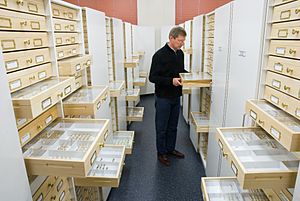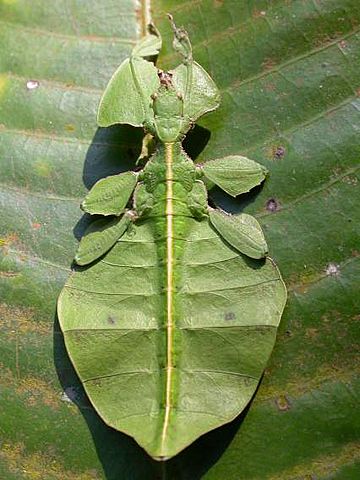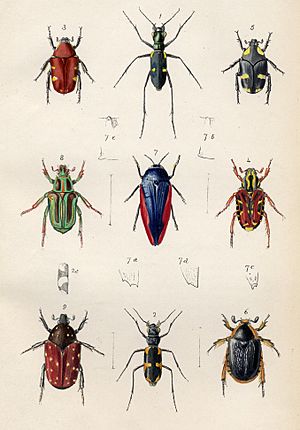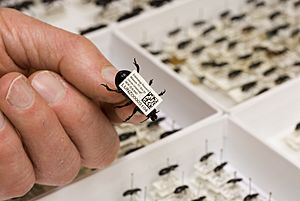Entomology facts for kids
Entomology is the scientific study of insects. It's a big part of zoology, which is the study of animals. In the past, the word insect was used more broadly. So, entomology used to include studying other arthropods too, like spiders, centipedes, and crabs. Sometimes, people still use the word this way informally.
Entomology is a field focused on one group of animals: insects! Any scientific study that looks at insects is called entomology. This means it connects with many other science areas. These include genetics, animal behavior, ecology (how living things interact with their environment), and even paleontology (the study of fossils).
There are over 1.3 million known insect species on Earth. That's more than two-thirds of all known species! Some insect species are incredibly old, dating back about 400 million years. Insects interact with humans and other life forms in countless ways.
Contents
The History of Studying Insects

People have been interested in insects for a very long time, even since prehistoric times. This was often because of agriculture, like beekeeping or trying to control pests. An ancient Roman writer named Pliny the Elder wrote about different kinds of insects. Later, in the 8th century, a scientist named Ibn al-A'rābī wrote a book specifically about flies!
Modern scientific study of insects really began in the 16th century. In 1602, Ulisse Aldrovandi published a book called Concerning Insect Animals. A microscopist named Jan Swammerdam correctly described how insects reproduce and how they change shape, a process called metamorphosis. In 1705, Maria Sibylla Merian published an amazing book about tropical insects from Dutch Surinam.
In the early days, people collected insects to put them in "cabinets of curiosity." This hobby became very popular, especially in Europe. It led to the creation of natural history societies and journals where people could share their discoveries. Many collectors were wealthy, and a trade in insects grew around the world. This time is sometimes called the "era of heroic entomology."
William Kirby is known as the father of entomology in England. With William Spence, he wrote a very important book called Introduction to Entomology. He also helped start the Royal Entomological Society in London in 1833. This was one of the first groups dedicated to studying insects.
As farming and trade grew in the late 1800s, "economic entomology" became important. This led to professional entomologists working at universities and helping with agriculture.
Entomology grew quickly in the 19th and 20th centuries. Many famous people studied insects, including Charles Darwin, Jean-Henri Fabre, and E. O. Wilson. Even Karl von Frisch, who won a Nobel Prize for studying bee communication, was an entomologist!
Today, many people enjoy identifying insects as a hobby. Butterflies and dragonflies are especially popular. It can be hard to identify insects down to their exact species because there are so many. For example, there are over 330,000 species of beetles alone! Often, you need special tools like a microscope to see the tiny differences between them.
Entomology and Pest Control
Entomologists also play a big role in controlling pests. In 1994, the Entomological Society of America started a special program. It helps people in the pest control business become "Associate Certified Entomologists" (ACEs). While most true entomologists have advanced degrees, ACEs are experts in pest management.
Different Kinds of Entomologists
Many entomologists choose to focus on just one type of insect. These special areas often have their own names:
- Coleopterology – studying beetles
- Dipterology – studying flies
- Odonatology – studying dragonflies and damselflies
- Hemipterology – studying true bugs
- Isopterology – studying termites
- Lepidopterology – studying moths and butterflies
- Melittology (or Apiology) – studying bees
- Myrmecology – studying ants
- Orthopterology – studying grasshoppers and crickets
- Trichopterology – studying caddisflies
- Vespology – studying social wasps
Famous Entomologists
Entomology Organizations
Just like other scientists, entomologists have many groups and societies where they can share ideas and research. These organizations can be local, national, or even international. Some focus on specific types of insects.
- Amateur Entomologists' Society
- Entomological Society of America
- Royal Entomological Society of London
- Société entomologique de France
- International Union for the Study of Social Insects
Insect Collections for Research
Many large insect collections are kept in museums, universities, or research centers around the world. These collections help scientists study insects and learn more about them. Here are a few examples:
Asia
- Zoological Survey of India
- Pakistan Museum of Natural History
Africa
- Natal Museum, Pietermaritzburg, South Africa
Australasia

- Lincoln University Entomology Research Collection, New Zealand
- Museum of New Zealand Te Papa Tongarewa, New Zealand
Europe
- Natural History Museum, London, United Kingdom
- Museum für Naturkunde, Berlin, Germany
- Muséum national d'histoire naturelle, Paris, France
United States
- American Museum of Natural History, New York City
- National Museum of Natural History, Washington, D.C.
- California Academy of Sciences, San Francisco
Canada
See also
 In Spanish: Entomología para niños
In Spanish: Entomología para niños
- Arachnology (study of spiders and scorpions)
- Medical entomology (insects and human health)
- Forensic entomology (insects in crime investigations)
- Cultural entomology (insects in human culture)





